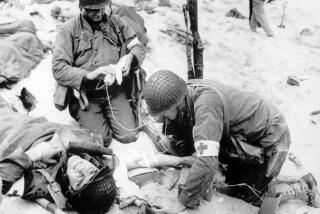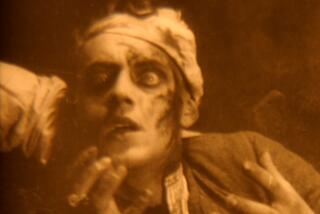The Writing Warrior : Books: The author of ‘The Face of Battle’ is back, with ‘The Second World War.’ His study of military history has convinced him that the World Wars were an aberration.
- Share via
The nerve-cracking bang of a backfire snaps the post-rush-hour calm of downtown Los Angeles. Walking back to his hotel, John Keegan flinches. It is a sensible reaction in a town where gunplay is not unknown, even beneath gleaming high-rises where packing iron is not the style among the pinstripe set.
And, given his background, Keegan’s reaction seems to make particular sense.
Although childhood tuberculosis left him lame and ineligible for military service, Keegan, 55, has lived more battles than any general. Through his historical imagination, he has described the combat styles of Alexander the Great, Napoleon, Grant and Hitler, as well as many important encounters on land and sea since the Middle Ages.
In Los Angeles recently for a lecture at USC, Keegan ranks near the top--perhaps first--among contemporary military historians.
His work includes “The Mask of Command,” “The Price of Admiralty” and “Six Armies in Normandy.” However, he is still best known for his first book, “The Face of Battle,” an eloquent but horrifying depiction of what combat was like for the average front-line soldier in various times and places.
With that volume, Keegan--a former senior lecturer in military history at Sandhurst, the British equivalent of West Point--established a following on both sides of the Atlantic. He also realized an author’s dream: continuing attention from critics and great space in book review columns.
Now Keegan is back with a 607-page, one-volume history, “The Second World War,” first published in Great Britain on Sept. 1, 1989, to mark the 50th anniversary of the biggest event in history and destroyer of an estimated 50 million lives.
Keegan sees World War II as a continuation of World War I, “a great interrupted event,” that extended the war of the trenches into the atomic era. And both wars, he maintains, were anomalies despite the prevalence of military violence in other centuries.
“When you take the two wars together, I think you see what an aberration they were in human affairs,” he says. “Our outlook on the world is colored by the normality of mass violence. . . . We’ve had these two great bloodlettings, and it sort of left us with the feeling that’s the way the world is. But I think we’ll look back and say the world needn’t be like that.”
Dressed in a double-breasted blazer with the anchor-emblazoned buttons of the Sandhurst Yacht Club, Keegan exudes self-assurance. Now the defense and military correspondent for the London Daily Telegraph, he displays the easy knowledge that comes from being a former professor who taught a course on WW II more than 80 times.
Because it is familiar terrain, Keegan says he did relatively little research for “The Second World War.” Nor did he come to any truly startling conclusions, a lack bemoaned by some critics.
But Keegan argues that “it’s very difficult to say anything new now.” In fact, Keegan believes some aspects of the war have been over-scrutinized. Specifically, he maintains in the opening of his history that the causes of both world wars have been over-researched, creating a thicket of obscuration around the wars’ origins.
Both wars, he explains, were fought because they could be fought.
“For the truth of 20th-Century European civilization was that the world it dominated was pregnant with war,” he writes. “Above all, and in dramatic and menacing counterpoint to the century’s works of hope and promise, it had created armies , the largest and potentially most destructive instruments of war the world had ever seen.”
Keegan says the 50th anniversary of WWII offers a poignant counterpoint to the death spread by the war itself.
The anniversary, he notes, is the “last time that large number of participants will be alive on a significant anniversary. When the 75th comes around, the survivors will be very old men--and they’ll be junior survivors, not senior survivors.”
Most of Keegan’s knowledge of WWII is derived from books and papers, as well as from a few early memories of wartime Britain, but he has met a handful of the war’s generals.
And although he thinks there isn’t much left unexplained about WWII, Keegan believes Soviet archives, once they become part of glasnost, will clear up some aspects of the conflict, especially regarding Soviet ability to read coded German radio traffic.
Further, Keegan says the archives may reveal whether Russia and Germany considered making peace at some point after their death struggle began with Germany’s 1941 invasion. “There are rumors that, indirectly, the Russians and Germans discussed making a separate peace one or two times during the war,” he says.
Keegan’s history is limited by the one-volume format. As a result, some parts at first glance seem to be an alphabet and Roman-numeral gumbo of military designations, such as division numbers and aircraft designations.
But Keegan manages to lard telling human revelations into the discussions of strategy.
For instance, in his brief treatment of the fight between U.S. Marines and the Japanese defenders of the Pacific island Iwo Jima, he writes: “ . . . riflemen dug trenches, which collapsed as soon as they were deep enough to give cover; wounded were wounded again as they lay out on the beaches awaiting evacuation . . . 6,821 Americans had been killed and 20,000 wounded, over a third of those who had landed; 21,000 Japanese defenders died almost to a man.”
Keegan says he came to his often grim specialty via his childhood bout with tuberculosis.
“I got it just before they invented the drugs,” he says. “In those days, the only effective cure was to lie in bed for very long stretches. I was in hospital really from the age of 13 to 17 and did a lot of reading. Yes, I do think it gives you that studious bent, and then you can’t play football and you go on being studious.”
He also says he was deeply affected by war’s unexpungeable impact on his father, a veteran of World War I.
“Nothing in his life ever got his attention as closely as that did,” he remembers.
The impact on Keegan seems to have been a deep ambivalence.
“I don’t think you can run this wicked world without armed force,” he says. “But I think that you have to take every reasonable and, if necessary, unreasonable measure to prevent the use of armed force. I can think of very few good wars.”
More to Read
Sign up for our Book Club newsletter
Get the latest news, events and more from the Los Angeles Times Book Club, and help us get L.A. reading and talking.
You may occasionally receive promotional content from the Los Angeles Times.







